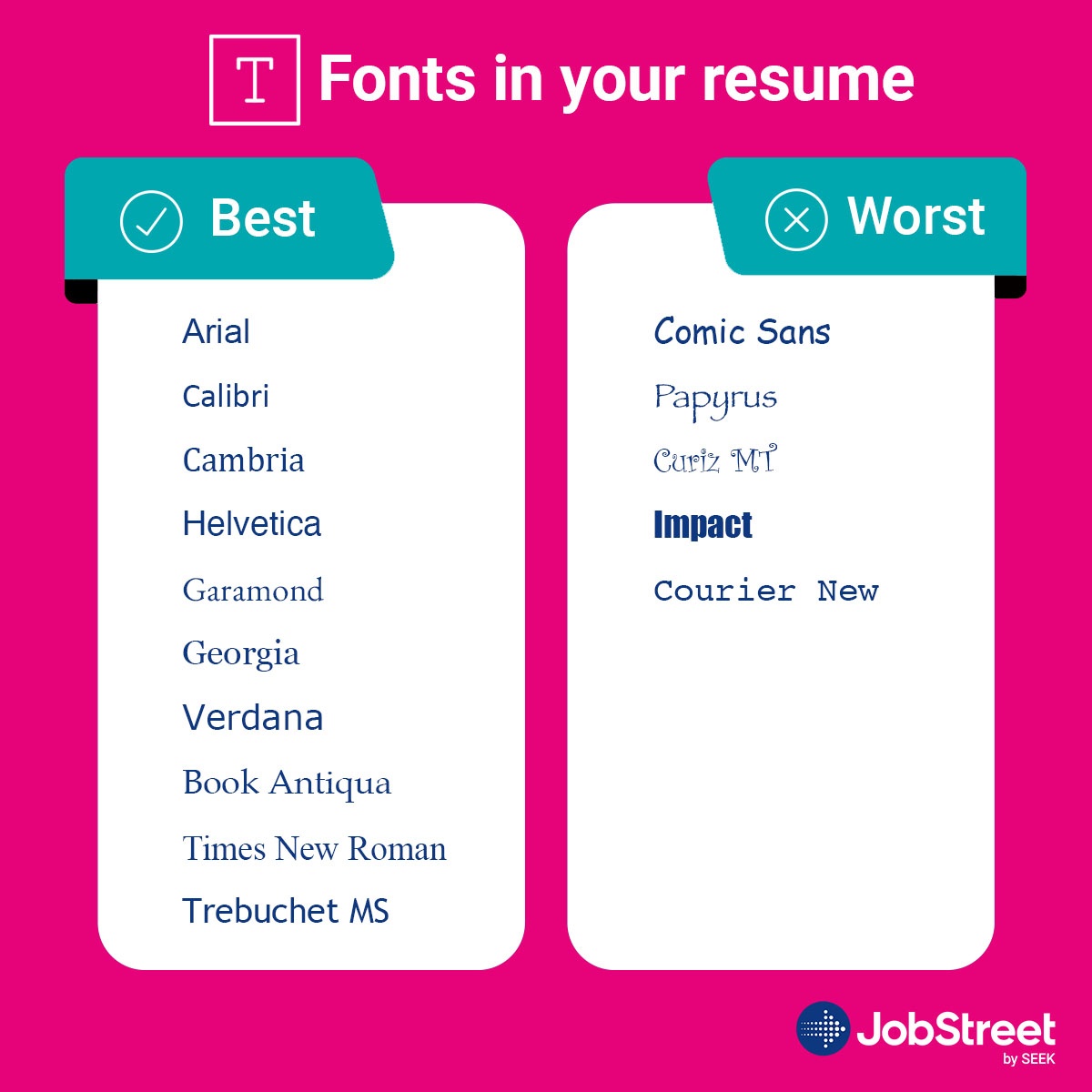The ultimate guide to choosing the best fonts for your resume: top fonts and tips
Would you ever apply to a company whose website is unironically plastered with Comic Sans? Neither would an employer hire you if you use Curlz MT on your resume.
Our MS Paint days are over, as are those of incomprehensible fonts. In resume writing, your font choice matters as much as your outfit for your job interview. The difference is employers see your resume first. So, choosing the best font for your resume is a task you should take seriously. Don’t worry — we’re here to help.
In this article, we’ll walk you through the basics of fonts, give tips on choosing the perfect resume font, and discuss the best and worst font choices for resumes.
- Understanding the basics of fonts
- Serif vs sans-serif typefaces
- Different font families and their characteristics
- Font size and spacing
- Factors to consider when choosing a font for your resume
- Top fonts for resumes
- Fonts to avoid in resumes
- Tips for using fonts in your resume
- Conclusion
- FAQs
Understanding the basics of fonts
Fonts are the windows to your digital personality. In this modern world, they have become one of the key elements of visual communication, impacting human perception and either piquing or averting interest.
Most of the time, people use the terms "fonts" and "typefaces" interchangeably. But technically, the two have distinctions. Fonts are a collection of letters, numbers, and symbols that come with their features, with various weights, widths, heights, contrasts, and styles. Conversely, typefaces are fonts with similar design elements and belong to the same family (hence the term "font family"). For instance, Helvetica is a typeface; Helvetica Neue Bold is a font under the Helvetica family.
Serif vs sans-serif typefaces
Serif typefaces
The serif (aka Roman) typeface derives its name from its eponymous distinguishing feature. According to the Oxford English Dictionary, a serif is "a slight projection finishing off a stroke of a letter in certain typefaces."
Serif typefaces have head and foot serifs (or flourishes at the end of their characters). Some of the most common and recognisable serif typefaces include Times New Roman, Garamond, Georgia, Courier New, and Baskerville.
You'll mostly encounter serif font families in printed materials, such as books, magazines, and newspapers. This is why serif typefaces make outputs seem traditional, classic, and formal.
Sans-serif typefaces
Simply put, sans-serif typefaces don't have serifs. Think Arial, Calibri, Helvetica, and Verdana. They are more widespread in digital media, with many users believing they appear cleaner and sleeker on screen. Even Microsoft Office replaced its default typeface (Times New Roman) with Calibri in 2007!
Recently, several brands have changed their logos from serif to sans-serif typefaces. Brands that have hopped on the sans-serif bandwagon include tech companies like Google, Yahoo, and Spotify, fashion brands like Burberry, Valentino, and Jimmy Choo, and giants from other industries like Wendy's and HSBC.
Because of its prevalence in this era, sans-serif typefaces are mostly perceived as modern and youthful.
Choosing between serif and sans-serif typefaces boils down to your preference and branding. Both have pros and cons and can be equally effective, depending on the context. Later in this article, you’ll learn the other factors that influence the perception of fonts.
Different font families and their characteristics

Aside from serif and sans-serif, fonts can fall under three other generic font family categories : script, display, and monospaced. Some of their characteristics may overlap. For instance, Courier New is a serif monospaced typeface; Impact is a sans-serif display typeface.
Script typefaces
As its name suggests, script typefaces mimic handwritten cursive. Typically, letters are connected with one another, but some script fonts are non-connecting, too.
There are formal script typefaces that look elegant and are often seen in wedding invitations, diplomas, and other ceremonial documents. Examples of formal script fonts include Edwardian Script, Vladimir Script, Lucida Calligraphy, and Palace Script MT.
There are also casual script typefaces which evoke a more playful vibe. Unlike formal script typefaces resembling longhand by pen nib, casual scripts seem to be created using a brush. Examples of casual script types include Brush Script, Freestyle Script, and Lucida Handwriting.
Display typefaces
Meant for display copy, display typefaces are made to draw attention. You’ll find them in headlines, logos, pull quotes, and other eye-catching design elements. They’re typically bold and decorative and are rarely used for regular bodies of text. Often, they’re best presented in uppercase and optimised for large sizes. Examples of display typefaces include Impact, Comic Sans, and Futura Black.
Monospaced typefaces
Donning the same width and horizontal space, monospaced typefaces were created for instances where alignment is crucial. Yes, there are specific jobs that require monospaced fonts.
For example, computer programmers need typefaces that keep codes aligned, distinguish similar letters and numbers from one another (i.e. “0” and “O”; “I” and “1”), and have sizable punctuation marks. Scriptwriters monospaced typefaces to time a script. Standard screenplays or broadcast scripts would use Courier 12-point double-spaced — using this format, one page of the script will take one minute of screen time.
Biochemists also use monospaced typefaces to display nucleic acid and protein sequences accurately. Even guitarists use this font family for tablature music, which needs chords to be visualised in a predictable fixed width.
Examples of monospaced fonts include Courier, Lucida Console, Consolas, and Source Code Pro.
Font size and spacing
Beyond font styles, choosing font size and spacing are also vital when working with typography.
Font size
Font size is the text measurement in points (pt) or pixels (px). The point size refers to the font height; one point is between 0.18 and 0.4 millimetres. Commonly, font sizes range from 8pt to 96pt. Most printed materials use 10- to 12-pointed text for their body.
In web design, font sizes are usually measured in pixels, with the default font size for regular text being 16px. When you format your text for headings, they typically have larger sizes.
Spacing
Spacing refers to the gaps between characters, lines, and blocks of text. In typography, spacing refers to both tracking and leading. Tracking is the space between characters; leading is the space between text lines. Both can impact the legibility and aesthetic of a font.
Factors to consider when choosing a font for your resume

Choosing a good font for a resume shouldn't be a chore. You only have to consider these four crucial factors to showcase your eligibility for your desired position effectively.
1. Industry and job type
Best fonts for formal resumes
Think about the conventions of the job you’re eyeing. Is it in a traditional industry, like finance, law, or government? If so, choose a formal typeface. Consider the following:
Times New Roman
You can’t go wrong with this classic serif font. It’s familiar, legible, and conveys a sense of reliability.
Georgia
If you find Times New Roman too dull, you can go for Georgia, which offers the same professionalism but with a modern touch.
Calibri
Submitting an online resume? You can consider Calibri, a classic sans-serif font.
Arial
Everyone knows and understands Arial. It’s clean and modern but also no-nonsense, which makes it a popular font choice for various industries.
Best fonts for creative resumes
If you’re applying for a job in the creative industry, it’s ideal to show your personality through your resume. Choosing a fun typeface will exhibit creativity, expression, and artistic flair. Aspiring artists, fashion designers, film producers, musicians, photographers, creative writers… these fonts are for you:
Avenir
A sleek sans-serif font, Avenir is stylish but legible. It’s a popular choice for industries in advertising, fashion, and design. Alternatively, you can also consider Montserrat and Proxima Nova — two typefaces that give the same modern but professional appearance.
Baskerville
Want your resume to exude timelessness and elegance? Use Baskerville, a serif typeface with graceful characters. You’ll see this in high-end fashion and beauty brands.
Garamond
In publishing and editorial industries, classic serif typefaces like Garamond are preferred. Since this typeface is often seen in printed materials, it’s legible in any size. But it’s also a sophisticated choice for those who want to add oomph to their resumes.
2. Personal brand and style
After considering your target job, reflect on your personal branding. Here are some questions you can ask yourself:
- Am I sophisticated and traditional? Or animated and youthful?
- Am I serious and traditional? Or playful and innovative?
- Am I classic and elegant? Or eccentric and avant-garde?
- Am I targeting Baby Boomers or Gen Z?
- Am I sending my resume to an SME or a conglomerate?
- Am I applying to an NGO or a government agency?
3. Readability and legibility
There's no sense in selecting a typeface that shows off your personality but isn't readable at all. If you want employers to read your resume, pick a font they can easily understand. Consider a font that can be readable on both print and digital platforms. Here are other factors to consider:
Size
If you're using a non-decorative typeface, font sizes ranging from 10 to 12 points are safe for the body. But if you opt for a display or script font (i.e. for a heading), you may need to enlarge the text.
Colour
When choosing a font colour, consider the background colour of your resume. It would be best to pick contrasting colours. For instance, use black font for white backgrounds. Having a lighter background and a darker font makes your resume more readable.
Serif
As mentioned earlier, sans-serif typefaces are typically more legible on digital devices. But you can also explore some serif typefaces with readable characters.
4. Applicant tracking systems (ATS)
A growing number of Malaysian companies use ATS to filter resumes. So, make sure yours is readable by the software by choosing an ATS-friendly typeface.
ATS recognises fonts with identifiable characters, such as Arial, Calibri, Avenir, Helvetica, and Times New Roman. It may have trouble detecting decorative typefaces, so steer clear of those. You can also use online tools like Jobscan and Resunate to ensure your resume is ATS-friendly.

Top fonts for resumes
- Arial
- Calibri
- Cambria
- Helvetica
- Garamond
- Georgia
- Verdana
- Book Antiqua
- Times New Roman
- Trebuchet MS
Fonts to avoid in resumes
- Comic Sans
- Papyrus
- Curlz MT
- Impact
- Courier New
Tips for using fonts in your resume

So you’ve finally decided on the best font choice for your resume. Here are some tips on how to incorporate your preferred typeface:
1. Be consistent in your font choice
In resume writing, less is more. Pick one to two professional fonts for your resume: one for the headings and one for the body. Using more than three fonts will make your resume look cluttered.
Limiting the number of fonts used in a resume to two or three at most is generally recommended. Using too many different fonts can make your resume look unprofessional and cluttered.
2. Stylise your text sparingly
Using bold or italic formatting can highlight critical information in your resume. But it's essential to use these only when needed. If your resume is excessively styled, it can look messy.
Here are some resume elements that you can format as bold:
- Section headings
- Job titles
- Key achievements
- Certifications or credentials
Meanwhile, these resume elements can stand out when italicised:
- Job descriptions
- Company names
- Extracurricular activities
- Publications or awards
3. Use font colours purposefully
Adding colour to your resume is a great way to spice it up. It’s also a way to draw attention to important details. But when choosing font colours, you must prioritise readability over aesthetics.
- Stick to a basic colour palette.
- Choose a dark colour that contrasts with the background.
- Use colours to emphasise important text.
- Consider how the colour would appear in different lighting conditions.
4. Avoid excessive use of capitalisation and underlining
You might be tempted to use capitalisation or underlines to highlight parts of your resume. Unfortunately, these two styles can seem outdated and unprofessional. Opt for bold and italic formatting if you want a modern-looking resume.
Conclusion
Your resume should represent who you are as a candidate. And choosing the best font for your resume will help showcase your worth.
You can choose from various font styles and characteristics, so have fun and explore! Just make sure to consider the industry you're eyeing. Your font choice will affect how an employer will perceive your application.
If you want to convey a formal resume, choose serif fonts like Times New Roman or Georgia. But if you're going for a more modern look, opt for sans-serif fonts like Calibri or Avenir. Whatever typeface you choose, ensure its legibility both on screen and print. Pay attention to font size, spacing, and colour, too!
Ultimately, the best font for your resume is a font that expresses your personality and reflects the job you're applying for. So please browse our list of top fonts for CVs and pick one that resonates with you the most.
Ready to write your resume? Download the JobStreet app for iOS or Android to access jobs on the go. Visit our Career Advice for more tips on job searching, career advancement, and self-improvement.
FAQs
- Can I use more than one font in my resume?
Yes. You can use two to three fonts in your resume. However, don't use too many, as doing so will make your resume look cluttered. You can use one font style for the section headings and another for the body text.
- Should I use a different font for my name and contact information?
Using a unique font can draw attention to a particular section. If you want to highlight your name and contact information, you can use a different font. Just make sure to pick a font that complements the rest of your resume.
- Can I use a decorative font for my resume?
Decorative fonts are not ideal for resumes. Traditional fonts like Times New Roman, Arial, Helvetica, and Georgia are easier to read. On the contrary, decorative fonts may hinder ATS software from decoding your resume.
If you want to add pizzazz to your resume, you can use a pop of colour, add icons or graphics, or experiment with different layouts.
- How do I know if my font choice is ATS-friendly?
ATS software can generally detect easy-to-read fonts, such as Times New Roman, Arial, Calibri, and Helvetica. You can use online tools like Jobscan and Resunate to check if your font choice is ATS-friendly.
- Is it okay to use a font that is not commonly used in resumes?We recommend using traditional fonts for resumes. But if you prefer a different typeface, ensure your choice is legible and ATS-friendly.
